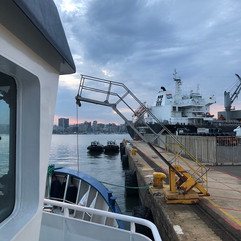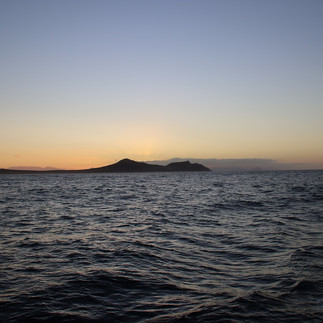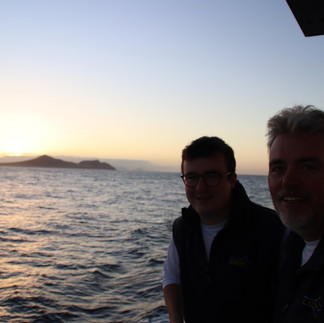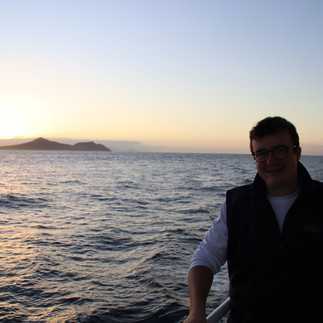Week 21 - Cape Final Day!
- iainmacneil
- Apr 26, 2022
- 7 min read

This week we rounded our 5th (and final) Cape, routing the Cape of Good Hope at sunrise on Tuesday 26th April.
Astra is now speeding back to Saint Helena where she is due to arrive early next week for a final before setting off on her last leg back to Lanzarote. More on that later! Let’s have a look at how the early part of the week panned out.........
Wed 20th April (Day 140) The day started with the news that the island ferry from Cape Town to Saint Helena, the MV HELENA, will not depart from Cape Town until Sunday 24th April, placing her only two days ahead of us, which means that as we arrive in to Saint Helena we will likely have to wait at anchor for the HELENA to finish her cargo operations and vacate the berth.
However, we are still two days from Durban at this point, experiencing some very awkward seas. The wind waves are opposing the prevailing swell, which is making it somewhat like a mechanical bucking bronco on a low setting!
Thu 21st April (Day 141) One day from Durban we started to notice a lot of debris in the water, from large plastic drums to a weighted telegraph pole that we suspect had a fairly large block of cement on the other end, making it bob up and down like a small nav mark. Mikey got quite a start when he saw it as it was right ahead of us and looked like an arm being raised above the waves.
We think most of this debris is the result of the awful and unusual flooding that Durban experienced a week earlier.
Fri 22nd April (Day 142)

At 08:00 as Iain should have been handing over the watch to Carlos, it was postponed as ASTRA was ‘standing on’ for a vessel on our port bow. Under the Rules of the Road at Sea, it was obliged to give way to ASTRA. Imagine our surprise when the cheeky chappie on the 170 metre long, 30,000 tonne MV ‘Southern Star’ called us on VHF Ch 16 and asked if we wouldn’t mind altering course for him, as he didn’t want to alter his course and start rolling, which would risk waking his sleeping crew. Please comment below with your answers on how Iain responded! (keep it clean......Ed)
At noo we recorded our highest speedier the course of a day, averaging 11.32 Knots as we pushed hard to arrive at the Pilot Station off Durban before their late afternoon shift change.
The shift change is at 18:00 Hrs, so we ensured we got to the Pilot Station at 16:15 hrs, which meant that while allowing for Pilot boarding and the transit in, we would be comfortably berthed in good time.
Durban, with its heavy swells and location on ‘The Wild Coast’ (more on that later), is a port where the Pilot often boards by helicopter. Around 16:00 a helicopter came out from the port and passed overhead. One minute later the port called us and instructed us to proceed in and the Pilot would board once we were within the breakwaters of the entrance channel. (Clearly, they had not been looking at Astra's journey.... A helicopter landing? Maybe a crane catch?!.......Ed)
Unusually, Port Control, the Coxswain of the Pilot boat and our berthing Pilot were all female. (Hurrah!......Ed)
We had tied up at 17:18 and bunkering started before 18:00. Within 2 hours we had loaded 36,000 litres of diesel, filling our main tanks and all our deck tanks to capacity.
The port could not have been more helpful and our agent and fuel supplier ensured everything was to done to turn us around quickly on a Friday evening.
We had a small wait for a Pilot but, with Durban being Paul’s hometown, he quietly ordered 5 local curries (the curries were ‘bunny-chow’, but I was assured they were actually lamb). We had time to enjoy them before the pilot boarded at 21:18 to assist our passage outbound.
*******************An Actually Very Interesting Nerd Alert *********************
About the extreme currents and waves along the South African coastline!
The Wild Coast Between Durban and East London we entered an area known as ‘The Wild Coast’ (and sometimes ‘Eastern Cape’). It is well known for its numerous shipwrecks and more than 2,500 shipwrecks have occurred along this coast since 1500. Some of the ships lost in these treacherous seas simply vanished without trace. (So glad you didn't say this last week!.....Ed)
The Agulhas Current The Agulhas current has been described as a 'river' that is 1,000 miles long, 60 miles wide and more than a mile deep, flowing at speeds of up to 6 knots in a SW direction along the Indian Ocean coastline of South Africa.

Cape Agulhas – Where the Indian Ocean meets the Atlantic Ocean
The currents of the two oceans meet, but do not mix, where the (warm-water) Agulhas current meets the (cold-water) Benguela current and turns back on itself. The Indian Ocean, on the east, is warmed by the Mozambique or Agulhas Current.which flows down from the tropics. The Atlantic, on the west coast, is cooled by the icy Benguela Current, which comes up from the Antarctic.
The confluence point where the Agulhas current meets the Benguela current is predominantly around Cape Agulhas, but it tends to fluctuate between Cape Agulhas and Cape Point (0.75’ E of CoGH) due to the changing seasons and the effect of the SE winds (from Nov to Mar - summer) and NW winds (from Apr to Oct – winter). The warm current can, on occasion, drift even as far as Cape Point.
Cape Agulhas was named by the Portuguese as Cabo das Agulhas, which is Portuguese for ‘Cape of Needles’, because they noticed that the compass needle, and the direction of magnetic north, coincided with true north in that area (at that time) (OK, Don't ask on that one....just accept that magnetic north moves around and......ok, look, just accept it!......Ed).
The Cape of Good Hope is not the southern-most tip of Africa, that honour belongs to Cape Agulhas, which is 80 miles further south.....but its not as pretty or as well known!
The Cape of Good Hope The Cape of Good Hope is infamously known as the 'graveyard of ships' and is also called the 'Cape of Storms'. When Portuguese explorer Bartolomeu Dias rounded it in 1488, he had a particularly bad experience so named it the ‘Cape of Storms’ because of the perilous sea. However, it was later renamed ‘Cape of Good Hope’, when it brought hopes of a new sea route to India.
Abnormal (Rogue or Freak) Waves (OK, now we are getting down to it.....Ed) Ships navigating in this area, during the Southern Hemisphere’s winter or the spring storms, can find winds of 100 mph generating incredibly large waves.
The unique characteristics of shoreline, continental shelf, ocean currents and strong winds can all come together to create dangerous and abnormal waves.
These abnormal waves are the result of SW’ly generated wind waves (at gale force or stronger) acting against the SW flowing Agulhas current (remember winds are described by the direction they come from....Ed). The waves generated in the current, particularly those on the inside edge of the body of current, can be twice as high as those outside the current.
The coastal region between Richards Bay and East London (The Wild Coast) is generally identified as the most dangerous because the shipping routes align with the inside edge of the current.
In extreme conditions, ships should move out of the current and go closer inshore. Astra kept between the 200m contour and the shoreline as in this area abnormal waves have never been recorded.
****************End of An Actually Very Interesting Nerd Alert ******************
The Skeleton Coast While we are not proceeding up the Namibian coast after passing CoGH, its interesting to know that the 'Skeleton Coast', as its called. was originally named after whale and seal bones that littered the shore from the whaling industry. However, in more modern times the coast displays the skeletal remains of the ships that have been torn up in the numerous rocks located off shore or having ran aground in fog.
Bit of a shipwreck theme developing here.......luckily we are moving swiftly on!
Sat 23rd April (Day 143)
Early morning we passed through a location where our latitude and longitude were exactly the same value at: 30° 30’S, 030° 30’E.
After that we entered the main body of the Agulhas current in the late afternoon and saw speeds exceeding 12 knots.
Monday 25th April (Day 145)
At 17:30 hrs we passed 7 miles south of Cape Agulhas, the most southern point of Africa. Sunset was just after 18:00 and we adjusted our speed to ensure that we arrive off the Cape of Good Hope (CoGH) the next morning to coincide with sunrise.
As we settled into a NW course after passing Cape Agulhas, we felt the influence of the Atlantic swell taking over and building up from the SSW. As night fell a pod of dolphins arrived to shepherd us around Cape Agulhas and we put on our searchlights to watch them playing in the dark.
Tuesday 26th April (Day 146)
Iain took over the watch from Dan at 05:00, some 16 miles from Cape Point at CoGH. They could both already see that it was going to be a fabulous morning for rounding the final Cape.
Iain had a few fishing boats to dodge and so Dan started on breakfast for all: Pancakes, crispy bacon and maple syrup.
The sun will due to rise over CoGH, bearing 074°, and Iain adjusted the speed to ensure Astra had the Cape and rising sun in alignment for 07:18 Hrs.(Of course he did.......Ed!)
At 07:05, Dan set about waking the rest of the crew and to assist in this task he had downloaded audio of a farmyard, with cockerels crowing, hens clucking, cows mooing and morning birdsong, which was played over the tannoy system. It was a very confused Mikey who arrived on the bridge a few minutes later, really not sure why he could hear a cockerel in his cabin. The bad boys Iain and Dan couldn’t control their laughter.
The last bottle of champagne onboard was one that had been received from Alfonso at Progener in Vigo, as a personal gift before we sailed in November. Progener oversaw 6 weeks of engine service works in Vigo as part of the final preparations for the circumnavigation and our engine has served us well over 26,800 miles!
The views of CoGH and the rising sun over Africa were truly stunning and a truly fitting backdrop for this final Cape. While the engine was on low RPM, Paul took the opportunity to top-up the oil with 40 litres and as he finished, Carlos slowly built up the RPM and took us to a speed of 11.5 knots on a great circle course of 307° bound for Saint Helena. We are on our way home! (Jeez, I just got ridiculously emotional reading that.........Ed)
ETAs
Saint Helena Mon 02 May PM
Berth Saint Helena Tue 03 May 16:00 (estimated)
ETA Lanzarote Sun 15 May







































So CIRCUMNAVIGATION complete??????
Iain,
Great update as always, spent a lot of my cadetship around the South African coast. I think it was before you joined Bibbys, but you may recall hearing of a bad accident the Devonshire had with a freak wave off Durban.
All good here and thoroughly enjoying life PS. (Post-SIGTTO)!
Safe sailing and all the best
Andy
Iain,
Glad to hear you are on the penultimate leg. I am sure the champagne tasted great.
I remember when we were getting the FSO Chevron Zenith to Singapore for, yet another, life extension. We couldn't clean the hull in situ 20 nm from the mouth of the Congo River and a S African dive firm recommended False Bay - "It is always beautiful." Well, not the week in August when the Zenith arrived for hull cleaning. Dive boat flipped and sank due to wave action. Fortunately, no one was injured. Zenith then crept over to Port Elizabeth for a partial hull cleaning, partial as strong winds challenged her mooring winches (she had been offshore Zaire for 15 years be…
Hi Mark,
Thank you again this week for taking the time to provide your thoughts on the weekly update. A few interesting parallels on this weeks theme in Phil Beaumont's post and my reply.
We are surfing in 4.5m seas at the moment towards Saint Helena, Kat hasn't put the porch light on yet, but we are both playing 'Going Home'. RunRig and Dire Straits versions.
The early 1990s were truly appalling years for shipping, the excess of ship's built in the 1970s were showing their age and sufferening from years of lack of maintenance. South Africa was not the only region where rogue waves were damaging ships, it was happening off Western Australia, where in the case the bow…
as always, fantastic log, what are we going to do in a few weeks time when you are finished, go on, do a lap of honour lol
that coast is well known to us old ben line folk, one of my favourite ships, BenCruachan, which i sailed on in 1978, had a very close shave as she was hit and broken / bent by a freak wave, she was towed backwards into Durban I think to get patched up to survive the journey back to europe for repairs
safe journey and good speed
Phil